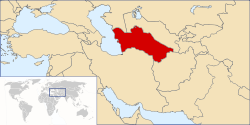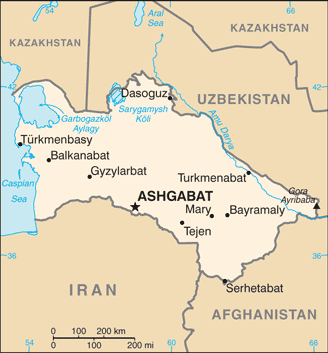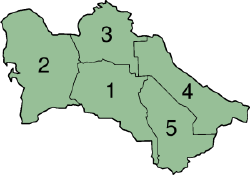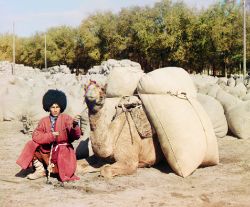Difference between revisions of "Turkmenistan" - New World Encyclopedia
Mike Butler (talk | contribs) m |
Mike Butler (talk | contribs) m |
||
| Line 66: | Line 66: | ||
== Geography == | == Geography == | ||
[[Image:Turkmenistan-map.png|left|350px|Map of Turkmenistan]] | [[Image:Turkmenistan-map.png|left|350px|Map of Turkmenistan]] | ||
| − | The name Turkmenistan is derived from Persian, meaning "land of the Turkmen people". | + | The name Turkmenistan is derived from Persian, meaning "land of the Turkmen people". The name Turkmen, both for the people and for the nation itself, is said to be self-referential from the period the Russians first encountered the people, parsing as Tūrk-men, or "I am Tūrk". |
It is bordered by [[Afghanistan]] to the southeast, [[Iran]] to the southwest, [[Uzbekistan]] to the northeast, [[Kazakhstan]] to the northwest, and the [[Caspian Sea]] to the west. | It is bordered by [[Afghanistan]] to the southeast, [[Iran]] to the southwest, [[Uzbekistan]] to the northeast, [[Kazakhstan]] to the northwest, and the [[Caspian Sea]] to the west. | ||
Revision as of 19:56, 22 April 2007
| Türkmenistan Turkmenistan | |||||
| |||||
| Anthem: Independent, Neutral, Turkmenistan State Anthem | |||||
| Capital (and largest city) |
Ashgabat 37°58′N 58°20′E | ||||
| Official languages | Turkmen | ||||
|---|---|---|---|---|---|
| Government | Single-party state | ||||
| - President | Gurbanguly Berdimuhammedow | ||||
| Independence | from the Soviet Union | ||||
| - Declared | 1991-10-27 | ||||
| - Recognized | 1991-12-08 | ||||
| Area | |||||
| - Total | 488,100 km² (52nd) 188,456 sq mi | ||||
| - Water (%) | 4.9 | ||||
| Population | |||||
| - December 2006 estimate | 5,090,000 | ||||
| - Density | 9.9/km² 25.6/sq mi | ||||
| GDP (PPP) | 2005 estimate | ||||
| - Total | $40.685 billion | ||||
| - Per capita | $8,098 | ||||
| HDI (2003) | 0.738 (medium) | ||||
| Currency | Turkmen Manat (TMM)
| ||||
| Time zone | TMT (UTC+5) | ||||
| - Summer (DST) | not observed (UTC+5) | ||||
| Internet TLD | .tm | ||||
| Calling code | +993 | ||||
Turkmenistan (also known as Turkmenia) is a country in Central Asia.
Until 1991 it was a constituent republic of the Soviet Union, the Turkmen Soviet Socialist Republic.
Eighty-seven percent of the population is Muslim.
Although it is wealthy in natural resources in certain areas, most of the country is covered by the Karakum (Black Sands) Desert.
It has a single-party system and was ruled by President for Life Saparmurat Niyazov until 21 December 2006, when he died of cardiac arrest. Presidential elections were held on 11 February 2007. Gurbanguly Berdimuhammedow was declared the winner with 89% of the vote. He was sworn in on 14 February 2007.
Geography
The name Turkmenistan is derived from Persian, meaning "land of the Turkmen people". The name Turkmen, both for the people and for the nation itself, is said to be self-referential from the period the Russians first encountered the people, parsing as Tūrk-men, or "I am Tūrk".
It is bordered by Afghanistan to the southeast, Iran to the southwest, Uzbekistan to the northeast, Kazakhstan to the northwest, and the Caspian Sea to the west.
At 188,457 square miles (488,100 square kilometers), Turkmenistan is the world's 52nd-largest country. It is comparable in size to Cameroon, and somewhat larger than the US state of California.
The center of the country is dominated by the Turan Depression and the Karakum Desert, which covers 135,135 square miles (350,000 square kilometres) or over 80 percent of the country. Shifting winds create desert mountains that range from six to 65 feet (two to 20 meters) in height, and may be several miles in length. Also common are are steep elevations and smooth, concrete-like clay deposits formed by the rapid evaporation of flood waters in the same area for a number of years. Large marshy salt flats, formed by capillary action in the soil, exist in many depressions, including the Kara Shor, which occupies 1,500 square kilometers in the northwest. The Sundukly Desert west of the Amu Darya river is the southernmost extremity of the Qizilqum Desert, most of which lies in Uzbekistan to the northeast.
Turkmenistan's average elevation is 100 to 220 meters above sea level, with its highest point being Mount Ayrybaba 10,291 feet (3137 meters) in the Kugitang Range of the Pamir-Alay chain in the far east, and its lowest point in the Transcaspian Depression 328 feet (100 meters) below sea level. The Kopet Dag mountain range, along the southwestern border, reaches 9553 feet (2912 meters). The Turkmen Balkan Mountains in the far west and the Kugitang Range in the far east are the only other significant elevations.
Turkmenistan has a subtropical desert climate that is severely continental. Summers are long (from May through September), hot, and dry, while winters generally are mild and dry, although occasionally cold and damp in the north. Most precipitation falls between January and May; precipitation is slight throughout the country, with annual averages ranging from 12 inches (300 millimeters) in the Kopet Dag to 3.14 inches (80mm) in the northwest. Average annual temperatures range from highs of 62°F (16.8°C) in Ashgabat to lows of 22°F (-5.5°C) in Daşoguz, on the Uzbek border in north-central Turkmenistan. The almost constant winds are northerly, north-easterly, or westerly.
Almost 80 percent of Turkmenistan lacks a constant source of surface water. Its main rivers are located only in the southern and eastern peripheries; a few smaller rivers on the northern slopes of the Kopetdag are diverted entirely for irrigation. The most important river is the Amu Darya, which has a total length of 1578 miles (2540km) from its farthest tributary, making it the longest river in Central Asia. The Amu Darya flows across northeastern Turkmenistan, thence eastward to form the southern borders of Uzbekistan and Tajikistan. Damming and irrigation uses of the Amu Darya have had severe environmental effects on the Aral Sea, into which the river flows.
Desertification and pollution has caused the biological productivity of the ecological systems in Turkmenistan to decline by 30 to 50 percent in the last decades of the twentieth century. The Karakum and Qizilqum deserts are expanding at a rate surpassed on a planetary scale only by the desertification process in the Sahara and Sahe] regions of Africa. Between 3000 and 4000 square miles (8000 and 10,000 km²) of new desert now appears each year in Central Asia.
Inefficient use of water causes salinization, the process that forms marshy salt flats, which is the most irreparable type of desertification. The main problem is leakage in main and secondary canals, especially Turkmenistan's main canal, the Garagum Canal. Nearly half of the canal's water seeps out into lakes and salt swamps along its path. Excessive irrigation brings salts to the surface, forming salt marshes that dry into unusable clay flats.
The type of desertification caused by year-round pasturing of cattle has been termed the most devastating in Central Asia, with the gravest situations in Turkmenistan and the Kazak steppe along the eastern and northern coasts of the Caspian Sea.
Over-use of fertilizer contaminates the ground water. The most productive cotton lands in Turkmenistan (the middle and lower Amu Darya and the Murgap oasis) receive as much as 250 kilograms of fertilizer per hectare, compared with the average application of 30 kilograms per hectare. Only 15 to 40 percent of the chemicals can be absorbed by cotton plants, while the remainder washes into the soil and subsequently into the groundwater.
Cotton also uses far more pesticides and defoliants than other crops, and application of these chemicals often is mishandled by farmers. For example, local herdsmen, unaware of the danger of DDT, have reportedly mixed the pesticide with water and applied it to their faces to keep away mosquitoes. In the late 1980s, a drive began in Central Asia to reduce agrochemical usage. In Turkmenistan the campaign reduced fertilizer use 30 percent between 1988 and 1989. In the early 1990s, use of some pesticides and defoliants declined drastically because of the country's shortage of hard currency.
Ashgabat, the capital city, had a population of 695,300 in 2001.Other main cities include Türkmenbaşy (formerly Krasnovodsk), and Daşoguz.
History
The territory of Turkmenistan has a long and checkered history, as armies from one empire to another decamped on their way to more prosperous territories. The region's written history begins with its conquest by the Achaemenid Empire of ancient Persia, as the region was divided between the satrapys of Margiana, Chorasmia and Parthia.
Alexander the Great conquered the territory in the 4th century B.C.E. on his way to India, around the time that the Silk Road was established as a major trading route between Asia and the Mediterranean Region. One hundred and fifty years later Persia's Parthian Kingdom established its capital in Nisa, now in the suburbs of the capital, Ashgabat. In the 7th century CE, Arabs conquered this region, bringing with them Islam and incorporating the Turkmen into Middle Eastern culture. The Turkmenistan region soon came to be known as the capital of Greater Khorasan, when the caliph Al-Ma'mun moved his capital to Merv.
In the middle of the 11th century CE, the Turks of the Seljuk Empire concentrated their strength in the territory of Turkmenistan in an attempt to expand into Afghanistan. The empire broke down in the second half of the 12th century, and the Turkmen lost their independence when Genghis Khan took control of the eastern Caspian Sea region on his march west. For the next seven centuries, the Turkmen people lived under various empires and fought constant intertribal wars. Little is documented of Turkmen history prior to Russian engagement. However, from the 13th to the 16th centuries, Turkmen formed a distinct ethnolinguistic group. As the Turkmen migrated from the area around the Mangyshlak Peninsula in contemporary Kazakhstan toward the Iranian border region and the Amu Darya river basin, tribal Turkmen society further developed cultural traditions that would become the foundation of Turkmen national consciousness.
Between the 17th and 19th centuries, control of Turkmenistan was fought over by Persian shahs, Khivan khans, the emirs of Bukhara and the rulers of Afghanistan. During this period, Turkmen spiritual leader Magtymguly Pyragy reached prominence with his efforts to secure independence and autonomy for his people. At this time the vast territory of Central Asia including the region of Turkmenistan was largely unmapped and virtually unknown to Europe and the Western world. Rivalry for control of the area between the British Empire and Tsarist Russia led to the establishment of The Great Game. Throughout their conquest of Central Asia, the Russians were met with the stiffest resistance by the Turkmen. By 1894, however, Russia had gained control of Turkmenistan and incorporated it into its empire. The rivalry officially concluded with the Anglo-Russian Convention of 1907. Slowly, Russian and European cultures were introduced to the area. This was evident in the architecture of the newly-formed city of Ashgabat, which became the capital. The October Revolution of 1917 in Russia and subsequent political unrest led to the declaration of the area as the Turkmen SSR, one of the six republics of the Soviet Union in 1924, assuming the borders of modern Turkmenistan.
The new Turkmen SSR went through a process of further Europeanization. The tribal Turkmen people were encouraged to become secular and adopt Western-style clothing. The Turkmen alphabet was changed from the traditional Arabic script to Latin and finally to Cyrillic. However, bringing the Turkmens to abandon their previous nomadic ways in favor of communism was not fully embraced until as late as 1948. Nationalist organizations in the region also existed during the 1920s and the 1930s.
When the Soviet Union began to collapse, Turkmenistan and the rest of the Central Asian states heavily favored maintaining a reformed version of the state, mainly because they needed the economic power and common markets of the Soviet Union to prosper. Turkmenistan declared independence on October 27, 1991,[1] one of the last republics to secede.
The former Soviet leader, Saparmurat Niyazov, remained in power as Turkmenistan's leader after the dissolution of the Soviet Union. Under his post-Soviet rule, Russian-Turkmeni relations greatly suffered.[citation needed] He styled himself as a promoter of traditional Muslim and Turkmen culture (calling himself "Turkmenbashi", or "leader of the Turkmen people"), but he quickly became notorious in the Western world for his dictatorial rule and extravagant cult of personality. The extent of his power was greatly increased in the early 1990s, and in 1999, he became President-for-Life.
Niyazov died unexpectedly on December 21, 2006, leaving no heir-apparent and an unclear line of succession. A former deputy prime minister rumored to be the illegitimate son of Niyazov,[2] Gurbanguly Berdimuhammedow, became acting president, although under the constitution the Chairman of the People's Council, Ovezgeldy Atayev, should have succeeded to the post. However, Atayev was accused of crimes and removed from office.
In an election on February 11 2007, Berdymukhamedov was elected president with 89% of the vote and 95% turnout, although the election was condemned by outside observers.[3]
Recent reports suggest that post-Niyazov Turkmenistan is already beginning to open up to the outside world. Internet cafes offering free and uncensored Web access have opened in Ashgabat [4], compulsory education has been extended from nine to ten years and classes in sports and foreign languages are being re-introduced into the curriculum, and there are plans to open several specialized schools for the arts. [5] President Berdymukhamedov has called for reform of education, health care and pension systems, and government officials of non-Turkmen ethnic origin who had been sacked by Niyazov have returned to work. [6]
President Berdymukhamedov has also begun to reduce the personality cult surrounding Niyazov and the office of the president. He has called for an end to the elaborate pageants of music and dancing that formerly greeted the president on his arrival anywhere, and has said that the Turkmen "sacred oath", part of which states that the speaker's tongue should shrivel if he ever speaks ill of Turkmenistan or its president, should not be recited multiple times a day but reserved for "special occasions." Previously the oath was recited at the beginning and end of TV news reports, by students at the beginning of the school day, and at the beginning of virtually all meetings of any official nature that took place in the country. [7]
Politics
The politics of Turkmenistan take place in the framework of a presidential republic, with the President both head of state and head of government. Turkmenistan has a single-party system.
Human rights
Human rights are generally not respected by many authorities in Turkmenistan, although some human rights are guaranteed in the Constitution of Turkmenistan. For instance equality rights, sex equality, freedom from cruel and unusual punishment, and freedom of movement. Social and economic rights include the right to work, the right to rest, and the right to education.
However, there are freedom of religion and freedom of sexuality issues. Any act of homosexuality in Turkmenistan is punishable by up to five years in prison. According to Forum 18, despite international pressure, the authorities keep a very close eye on all religious groups and the legal framework is so constrictive that many prefer to exist underground rather than to have to pass through all the official processes, which act as barriers.[citation needed] Protestant Christian adherents are affected,[citation needed] in addition to groups such as Jehovah's Witnesses and the followers of the Hare Krishna movement. The Hare Krishna followers are not allowed to seek donations at the country's main airport, Ashgabat.
According to the 2005 Reporters Without Borders World Press Freedom Index, Turkmenistan had the second-worst press freedom conditions in the world behind North Korea.
Administrative divisions
Turkmenistan is divided into five provinces or welayatlar (singular - welayat) and one independent city:
| Division | ISO 3166-2 | Capital City | Area (sq. km) | Area (sq. mi) | Pop (1995) | Key |
|---|---|---|---|---|---|---|
| Ashgabat | Ashgabat | 604,000 | ||||
| Ahal Province | TM-A | Annau | 95,000 | 36,680 | 722,800 | 1 |
| Balkan Province | TM-B | Balkanabat | 138,000 | 53,280 | 424,700 | 2 |
| Daşoguz Province | TM-D | Daşoguz | 74,000 | 28,570 | 1,059,800 | 3 |
| Lebap Province | TM-L | Turkmenabat | 94,000 | 36,290 | 1,034,700 | 4 |
| Mary Province | TM-M | Mary | 87,000 | 33,590 | 1,146,800 | 5 |
Economy
One half of its irrigated land is planted in cotton, making it the world's 10th-largest producer. It possesses the world's fourth-largest reserves of natural gas and substantial oil resources. In 1994 the Russian government's refusal to export Turkmen gas to hard currency markets and mounting debts of its major customers in the former Soviet Union for gas deliveries contributed to a sharp fall in industrial production and caused the budget to shift from a surplus to a slight deficit.
Turkmenistan has taken a cautious approach to economic reform, hoping to use gas and cotton sales to sustain its economy. In 2004, the unemployment rate was estimated to be 60%; the percentage of the population living below the poverty line was thought to be 58% a year earlier.[2] Privatization goals remain limited. Between 1998 and 2002, Turkmenistan suffered from the continued lack of adequate export routes for natural gas and from obligations on extensive short-term external debt. At the same time, however, the value of total exports has risen sharply because of higher international oil and gas prices. Economic prospects in the near future are discouraging because of widespread internal poverty and the burden of foreign debt.
President Niyazov spent much of the country's revenue on extensively renovating cities, Ashgabat in particular. Corruption watchdogs voiced particular concern over the management of Turkmenistan's currency reserves, most of which are held in off-budget funds such as the Foreign Exchange Reserve Fund in the Deutsche Bank in Frankfurt, according to a report released in April 2006 by London-based NGO Global Witness. According to the decree of the Peoples' Council of 14 August 2003,[3] electricity, natural gas, water and iodized salt will be provided free of charge to citizens up to 2030; however, shortages are frequent. On September 5 2006, after Turkmenistan threatened to cut off supplies, Russia agreed to raise the price it pays for Turkmen natural gas from $65 to $100 per 1,000 cubic meters. Two-thirds of Turkmen gas goes through the Russian state-owned Gazprom.[4]
Demographics
The majority of Turkmenistan's citizens are ethnic Turkmen with sizeable minorities of Russians and Uzbeks. Smaller minorities include Ukrainians, Kazakhs, Azeris, Armenians and Tatars. Turkmen is the official language of Turkmenistan, though Russian still is widely spoken as a "language of inter-ethnic communication" (per the 1992 Constitution).
The name Turkmen, both for the people and for the nation itself, is said to be self-referential from the period the Russians first encountered the people, parsing as Tūrk-men, or "I am Tūrk"[citation needed].
Culture
Education is universal and mandatory through the secondary level, the total duration of which was recently reduced from 11 to 9 years.
- Akhal-Teke horse breed
- Yomut carpet
- Geok-Tepe
- Islam in Turkmenistan
- Merv
- Music of Turkmenistan
Miscellaneous topics
- Communications in Turkmenistan
- Foreign relations of Turkmenistan
- Human rights in Turkmenistan
- Military of Turkmenistan
- Scouting in Turkmenistan
- Transport in Turkmenistan
- Agriculture in Turkmenistan
Further reading
- Bradt Travel Guide: Turkmenistan by Paul Brummell
- Historical Dictionary of Turkmenistan by Rafis Abazov
- Lonely Planet Guide: Central Asia by Paul Clammer, Michael Kohn and Bradley Mayhew
- The Great Game: The Struggle for Empire in Central Asia by Peter Hopkirk
- Tradition and Society in Turkmenistan: Gender, Oral Culture and Song by Carole Blackwell
- Tribal Nation: The Making of Soviet Turkmenistan by Adrienne Lynn Edgar
- Eastward to Tartary: Travels in the Balkans, the Middle East, and the Caucasus by Robert D. Kaplan
- Unknown Sands: Journeys Around the World's Most Isolated Country by John W. Kropf
- Rall, Ted. "Silk Road to Ruin: Is Central Asia the New Middle East?" New York: NBM Publishing, 2006.
ReferencesISBN links support NWE through referral fees
- ↑ Tribe, Class, and Nation in Turkmenistan, page 1 Tribal Nation: The Making of Soviet Turkmenistan
- ↑ CIA World Factbook. government publication. Central Intelligence Agency (19 December 2006). Retrieved December 21, 2006.
- ↑ Resolution of Khalk Maslahati (Peoples' Council of Turkmenistan) N 35 (14.08.2003)
- ↑ [1]
External links
- Official Website of the Government of Turkmenistan
- Open Directory Project - Turkmenistan directory category
- The Turkmenistan Project - weekly news and analysis in English and Russian
- CIA Factbook
- Photo Gallery from Turkmenistan (in German)
- Encyclopedia of the Nations
- All schools of Turkmenistan (Russian)
- BBC News country profile
- View Ashgabat, Dashoguz, and Mary on Google Earth
Template:Countries of Central Asia
Afghanistan · Armenia · Azerbaijan1 · Bahrain · Bangladesh · Bhutan · Brunei · Cambodia · China, People's Republic of · China, Republic of (Taiwan)2 · Cyprus · Egypt3 · Georgia1 · India · Indonesia4 · Iran · Iraq · Israel · Japan · Jordan · Kazakhstan1 · Korea, Democratic People's Republic of · Korea, Republic of · Kuwait · Kyrgyzstan · Laos · Lebanon · Malaysia · Maldives · Mongolia · Myanmar · Nepal · Oman · Pakistan · Philippines · Qatar · Russia1 · Saudi Arabia · Singapore · Sri Lanka · Syria · Tajikistan · Thailand · Timor-Leste (East Timor)4 · Turkey1 · Turkmenistan · United Arab Emirates · Uzbekistan · Vietnam · Yemen3
For dependent and other territories, see Dependent territory and List of unrecognized countries.
1 Partly or significantly in Europe.
2 The Republic of China (Taiwan) is not officially recognized by the United Nations; see Political status of Taiwan.
3 Partly or significantly in Africa.
4 Partly or wholly reckoned in Oceania.
Template:Caspian Sea Template:Commonwealth of Independent States
| Member states and observers of the Organization of the Islamic Conference (OIC) | |||||||
|---|---|---|---|---|---|---|---|
| Members |
| ||||||
| Observers |
| ||||||
Federal subjects of Russia shown in italics
Western Turkic |
|
|
|
1 Includes the Nakhchivan Autonomous Republic. 2 Recognized only by Turkey; see Cyprus dispute.
Credits
New World Encyclopedia writers and editors rewrote and completed the Wikipedia article in accordance with New World Encyclopedia standards. This article abides by terms of the Creative Commons CC-by-sa 3.0 License (CC-by-sa), which may be used and disseminated with proper attribution. Credit is due under the terms of this license that can reference both the New World Encyclopedia contributors and the selfless volunteer contributors of the Wikimedia Foundation. To cite this article click here for a list of acceptable citing formats.The history of earlier contributions by wikipedians is accessible to researchers here:
The history of this article since it was imported to New World Encyclopedia:
Note: Some restrictions may apply to use of individual images which are separately licensed.




